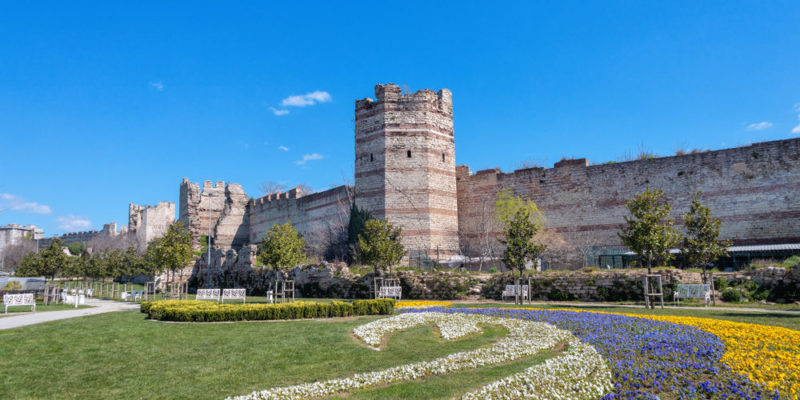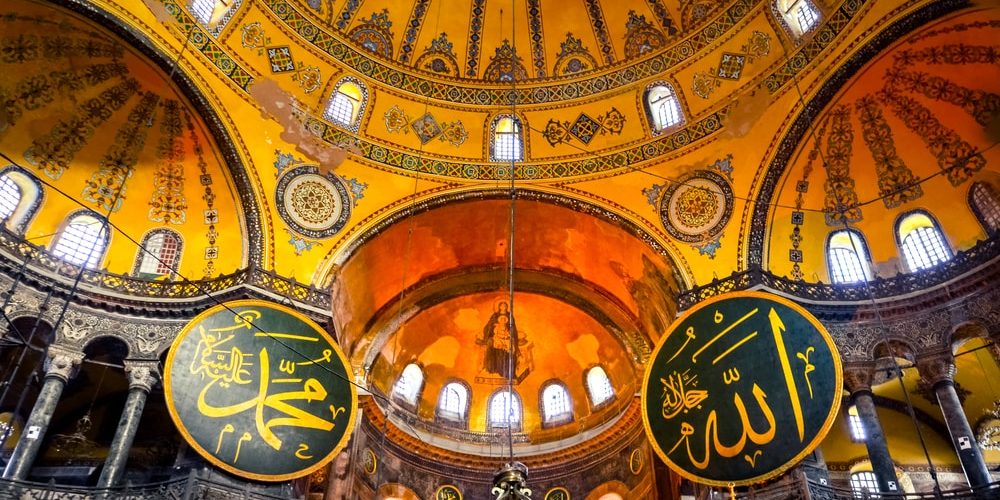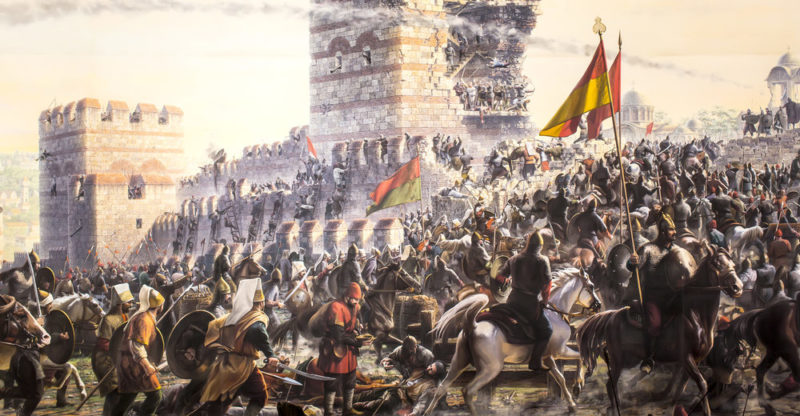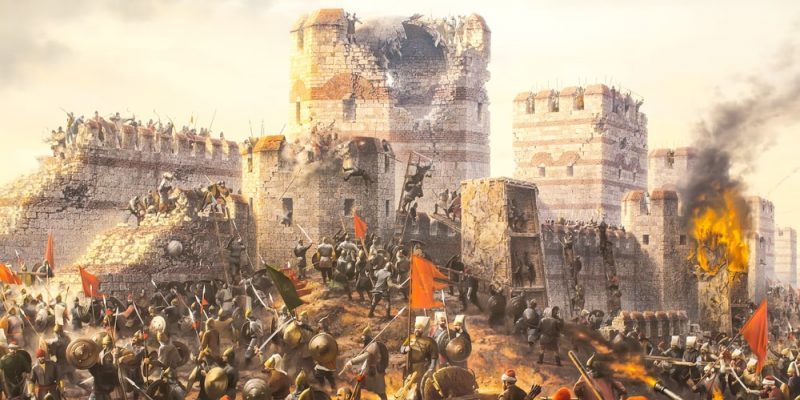We explain what the Byzantine civilization was and how it originated. In addition, what are its main characteristics and current status?
What was the Byzantine Civilization?
By Byzantine civilization, also known as Byzantium, we usually refer to the inhabitants of the Byzantine Empire or Eastern Roman Empire, one of the two parts into which the Roman Empire was divided in the fourth century.
This civilization initially consisted of a multi-ethnic Christian people, of strong Hellenic roots, who referred to themselves as "Romans" ( romioi ), but who ended up being Greek Orthodox.
The capital of this Empire and the center of Byzantine civilization was Byzantine, a Greek colony located near the Bosphorus Strait, in a part of what is now the city of Istanbul.
This city was re-founded by the Roman Emperor Constantine the Great, during the height of the Roman Empire in 330 AD. C., under the name of New Rome, although the population always chose to call it Constantinopolis ("the city of Constantine").
Greek origins of Byzantine civilization
The foundation of Byzantium, the Greek capital of Thrace located in present-day Turkey, is attributed to the Greek Byzantine or Byza who would be, according to tradition, the son of the nymph Ceroesa and, therefore, a descendant of Poseidon.
This would have happened around the year 667 a. C., taking advantage of its strategic location to control Eastern Europe, the Balkans, and North Africa.
Byzantium would have played an important role in the Greek economy and also in its long history of internal wars, as well as its destiny under the tutelage of the nascent Roman Empire, of which it formed part as one of the impoverished Roman cities in Asia .
Refoundation of Byzantium

The history of Byzantium takes a turn during the heyday of the Roman Empire, around the fourth century, when its great dimensions forced a rethinking of its political organization: Rome was too far from its borders to serve as an effective capital, and Emperor Constantine (himself which would implant Christianity as the official religion) decided to reform Byzantium to make it the new capital.
This implied the construction of enormous walls, which turned the city into an impregnable fortress until the end of the Middle Ages, whose fleet and port power gave it an important role in the economy of the Mediterranean.
Decades later, after the death of Emperor Valens, his two sons inherited the throne and divided the empire in two: the Western Roman Empire (based in Rome) and the Eastern Roman Empire (based in Byzantium), which ended up being the capital of the Byzantine Empire.
Population data of the Byzantine civilization
It is estimated that the Byzantine civilization was home to some 25 million people throughout an area of almost 1,600,000 km 2.
Its largest population concentration was always on the Asian side and it consisted of large cities apart from Constantinople, such as Alexandria, Antioch, Ephesus, Pergamum, Trebizond, Edessa, Nicaea, Thessalonica, or Thebes, many of ancient Hellenic greatness.
Social characteristics of the Byzantine civilization

Given its privileged location, Byzantium was a point of cultural and ethnic convergence, characterized by a highly varied population.
The Byzantines identified at the same time with their Hellenic Greek tradition, their Roman citizenship, and their Christian religion, which gives us an idea of the richness of their culture and the diversity of its tributaries.
Identification with ancient Greece increased during the 9th century and even lasted after the fall of the empire under the Ottoman conquest and the establishment of Turkish society. The Byzantines continued to embrace their unique heritage until the 20th century.
Byzantine culture

In Byzantium, the official language quickly passed from the Latin of the Roman Empire to Greek, so that some positions such as emperor had different names: Basel Romanian for Roman Empire, for example, since the Byzantines never named themselves otherwise. "Byzantine Empire" is a much later historical term.
Similarly, the official religion was Christian but far removed from the processes that the Church went through in the West, it ended up being converted into the Orthodox Church, which still survives in Greece, Russia, and other Eastern European territories.
Religion held an important place among the intellectuals of the time, whose endless diatribes gave rise to the expression "Byzantine discussion" to allude to a passionate debate regarding irrelevant issues.
The economy of Byzantine Civilization

Since its Greek times, the Byzantine culture had a considerable economic abundance, given its advantageous position for the control of maritime trade through the Bosphorus, and its extensive crops (cereals and fruits) and leather and textile works that it developed in the region, despite being under constant siege by neighboring towns.
Its time of economic decline takes place under Roman tutelage, since the conditions of poverty and abandonment in which the empire maintained its Asian territories are known.
In addition, it was quickly involved in the internal conflicts of Roman politics and was besieged on several occasions, one of the most devastating was led by Emperor Lucius Seventh Severus, which lasted three years and left the city practically in ruins.
The political organization of the Byzantine civilization
Once declared the capital of the Roman Empire, ancient Byzantium, now Constantinople was embellished and remodeled to reflect its imperial importance.
Thus, it became the bureaucratic, political and military headquarters of an empire that lasted more than a thousand years, despite the fact that its borders were under constant siege and only diminished after the Byzantine imperial heyday in the 6th century, under the mandate of the Emperor Justinian.
Just like its western variant, which collapsed and dissolved much earlier, the Byzantine Empire was ruled by a caste of monarchs whose succession was always problematic, since there were no fixed laws for the transfer of the crown and it lent itself to conspiracies and struggles between the elites. The link between the church and the monarchy was clear, constant, and evident.
Territorial characteristics of the Byzantine civilization

The territory of the Byzantine Empire varied greatly throughout its centuries of duration. Its peak moment took place around 550, when all of the current territories of Italy, Greece, southern Spain, North Africa, Egypt, Palestine, Syria, the Mediterranean islands, and current Turkey.
Byzantine culture was exported in an attempt to regain the borders of the old Roman Empire.
However, as time passed, Byzantium saw its territory diminish as Islam invaded the African coasts and exerted its influence in the Mediterranean, seizing the territories of Egypt, Syria, and Palestine.
Other enemies such as the Kingdom of Bulgaria, the invading Lombard peoples, and finally the Ottomans, eventually sentenced the fall of the Byzantine Empire when they besieged Constantinople in the 15th century.
Military characteristics of the Byzantine civilization

For centuries, the Byzantine army was the most powerful in Europe, famous for its heavy cavalry, the cataphract. The same happened with their agile boats, the drones, or the use of "Greek fire", which gave them maritime superiority in the Mediterranean until the 11th century.
End of the Byzantine Empire

After the Ottoman conquest, the Byzantine Empire disappeared, but not the patriotic sentiment of its citizens, who insisted on calling themselves "Romans" even though they could speak different languages and were under Arab rule.
Eventually, the city was renamed Istanbul (from Turkish Istanbul ) and to this day it preserves the traces of its multi-ethnic history.
The above content published at Collaborative Research Group is for informational and educational purposes only and has been developed by referring to reliable sources and recommendations from technology experts. We do not have any contact with official entities nor do we intend to replace the information that they emit.
Passionate about understanding and contributing to a world that does not stop changing. New forms of Work, Sustainability and Technology. For many years he has worked as a creative for large international companies. He has a Ph.D. in information technology and he has been doing quantitative research in the interdisciplinary areas of information systems, cyber security, data analytics and artificial intelligence. He continue to look for creative solutions through technology to help companies to be more humane and sustainable..
Leave a reply
Your email address will not be published. Required fields are marked *Recent post

Sport: What Is It, Types, Risks, Features, Characteristics and Examples

Dogs: Emergence, Features, Characteristics, Feeding and Breeds

Story: Definition, Elements, Structure, Features and Characteristics

